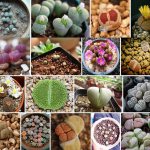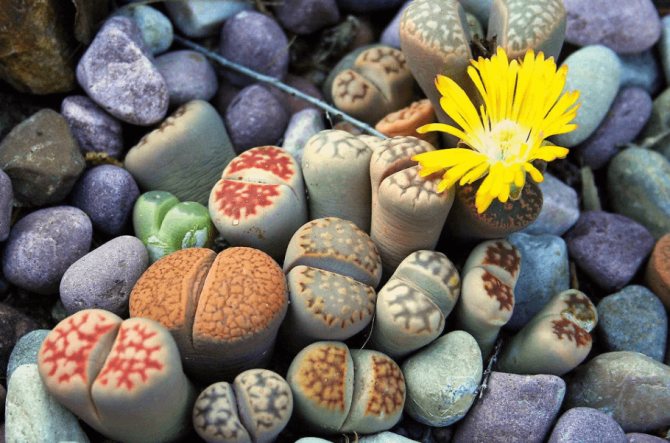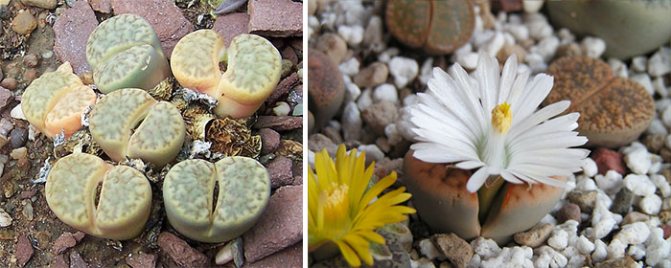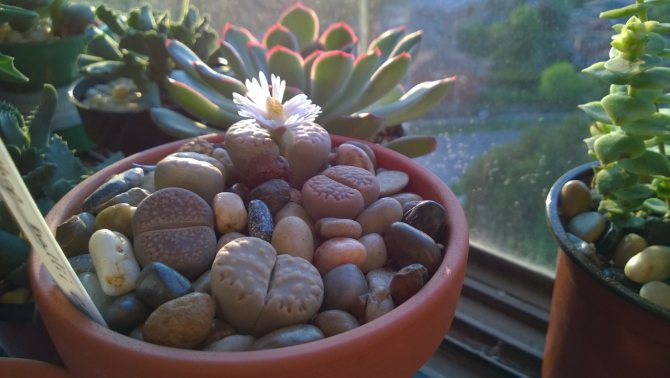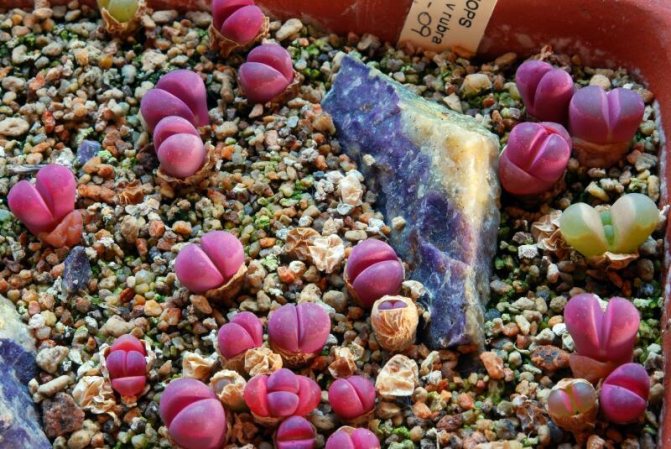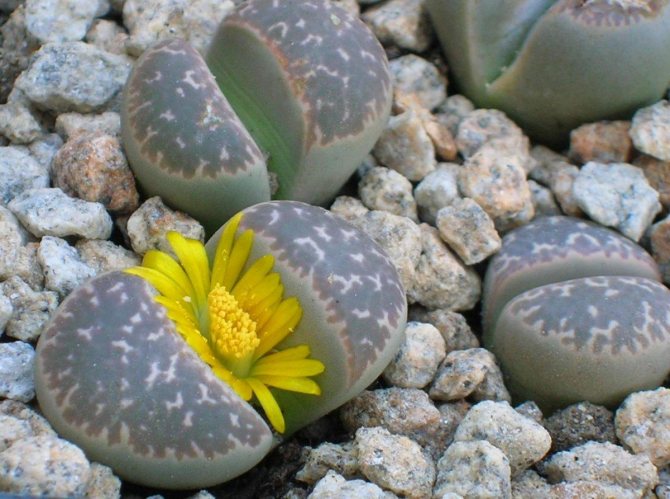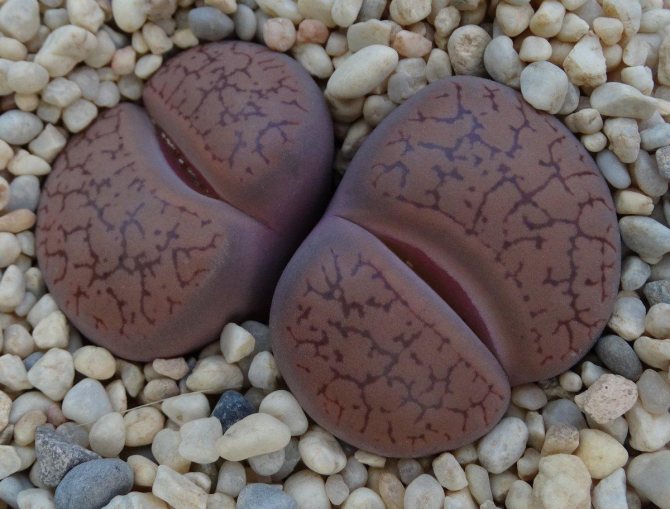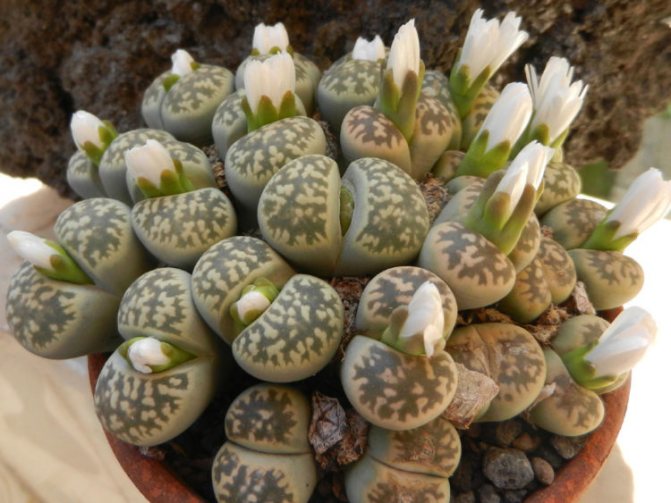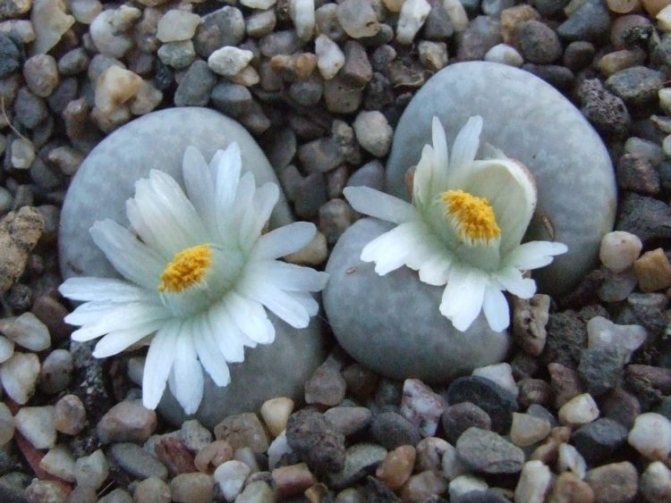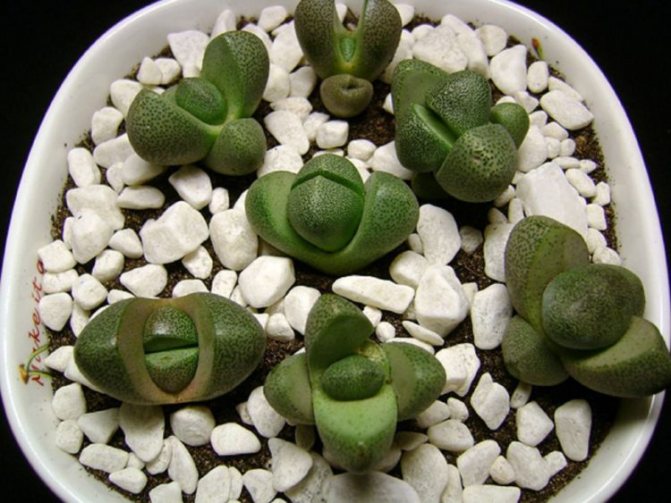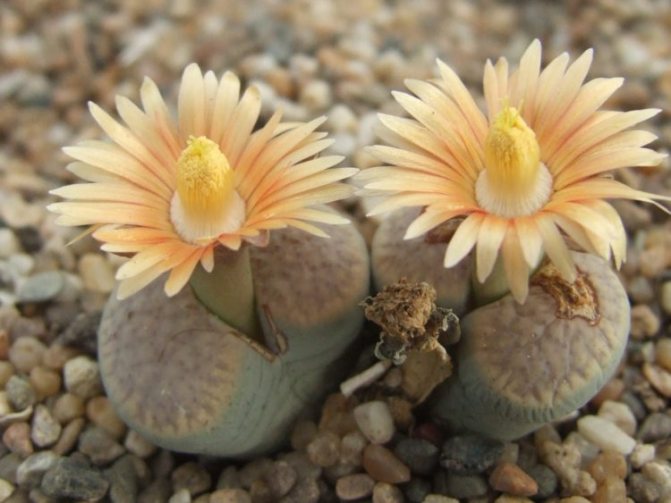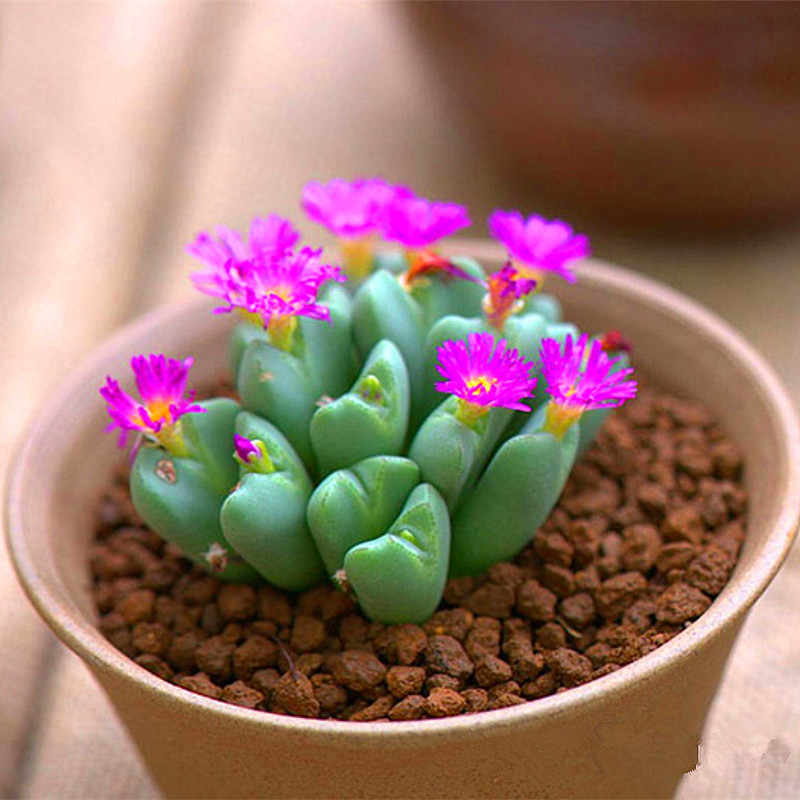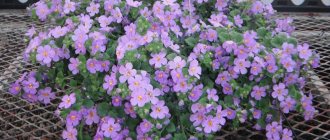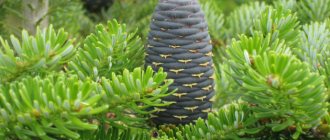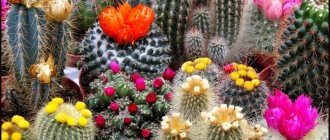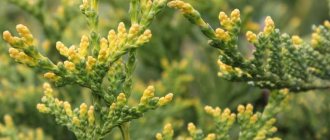Succulent plants such as lithops also called "living stones". Under natural conditions, these not quite ordinary plants grow in stony deserts, and they can be quite easily confused with pebbles, since they are small, round in shape, and the color repeats the color of the soil on which they grow. And the most interesting thing is that these plants are flowering. But do lithops grow in indoor conditions?
The genus Lithops (Lithops) is directly related to the family of mesembriantemic or Aizovye (Aizoaceae). To date, 37 species of this genus are known (some of the species are divided into subspecies). It is sometimes very difficult to determine exactly which species a particular plant belongs to, because its color and some other features are very changeable, and directly depend on the habitat.
Under natural conditions, lithops can be found in the rocky deserts of Southwest and South Africa. They are able to grow even in places where other plants do not survive. The plant is able to easily tolerate huge temperature changes. So, in its habitats, most often in the daytime the temperature rises to 50 degrees, and at night it is very cold there. These plants prefer to grow on scree, on granite chips, on the southern slopes, on very hard clayey soil.
The color of lithops is very different and it can change depending on the color shade of the soil. So, the color of the leaves ranges from brown or even purple to green or gray. The plant has a pair of fleshy leaves, which can be either flat or convex. Often on their surface you can see various patterns, as well as spots, and almost every species has its own.
The opened flowers are quite large (2 to 4 centimeters in diameter), which, as a rule, exceeds the size of the lithops itself. The blossoming flower withers only after 10 days. Most often, in spring, 2 new leaves grow to replace the old ones.
You can easily grow these not quite ordinary "living stones" at home. You need to take care of them in almost the same way as for cacti. However, experienced flower growers do not recommend planting lithops in separate pots, and it is better to plant them in not very large groups.
Botanical description and cyclical development of lithops
According to the botanical classification, Lithops (Latin Lithops) is a genus of succulent plants of the Aizovye family (Latin Aizoaceae). The aerial part of Lithops is a pair of almost accrete leaves in the form of an inverted cone or cylinder, sitting on a very short, thick stem. Sometimes the trunk is completely missing and the leaves are attached directly to the root. The upper part of the leaf is translucent, with the help of this light window, the process of photosynthesis takes place. There is a small gap between the leaves, from where flower stalks and young leaves grow. The flowers are very beautiful, white or yellow, and have a pleasant scent. After flowering, the fruit appears in the form of a capsule that opens up from the rain.
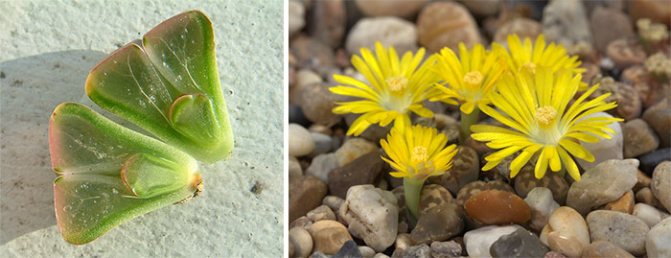
These succulents are very small in size. Plant height usually does not exceed 4-5 cm, some species can be even lower - about 2 cm.
In nature, all lithops have a pronounced annual growth cycle, depending on the length of daylight hours and the amount of precipitation.
In summer, when the day is at its longest and there is no rain, the lithops is dormant, neither growing nor blooming. In the fall, the day becomes shorter, it rains, and the plant begins to wake up: a peduncle grows in the crack between the leaves, a flower appears, and then a fruit with seeds.
In winter, the duration of the light period decreases to a minimum, but the lithops continues to develop. The old pair of leaves gradually shrivels, and young leaves take its place. In the spring, precipitation begins again, the succulent again stores moisture, but already in fresh leaves, the previous ones die off, turning into a dry paper-like skin, and fall off.


We can say that in a year, lithops completely renews the aboveground part. It is interesting that a young pair of leaves is always perpendicular to the old one, and sometimes not two, but four leaves appear at once, thus the succulent grows.
Popular species and varieties
Today, at least 35 species of lithops are known, which differ, as a rule, in flowers and patterns on the leaves. Almost all of them are grown at home, the most common of which are:
Lithops aucampiae is a South African species named after Juanita Aucamp, who discovered the plant on her father's farm. It is a succulent with two thick fleshy leaves of a brown or brown hue, in the upper part of which there are translucent light windows. The leaves are separated by a crack, from which a rather large yellow flower emerges. Several varieties are known:
- Jackson's Jade - golden green.
- Green River - yellow-green.
- "Chieruby" (Chirubi) - red-pink.
Lithops Bromfield (lat.Lithops bromfieldii) is a succulent with an unusual marble pattern in the upper part of the leaf: maroon veins on a pinkish background. Flowers can be white, red, or orange. The "White Nymph" variety with large white flowers is often found on sale.
Lithops of Compton (lat.Lithops comptonii) is distinguished by flowers, painted in two shades: a white center and bright yellow ends of the petals. This is one of the southernmost plant species, the annual cycle of which is the opposite of the standard one: a flower appears in summer, and a dormant period begins in winter.


L. Aucamp, L. Bromfield, L. Compton
Dorothea's lithops (lat.Lithops dorotheae) is a very miniature species no more than 1 cm high. The succulent leaves are perfectly disguised as fine-grained quartz and feldspar, among which it grows. The plant can only be found due to its bright yellow, rather large flowers.
Lithops Franz (lat.Lithops francisci) is a common species from Namibia, often found on sale. The popularity of this plant almost led to the destruction of natural colonies; thousands of specimens were dug up and taken out of their native habitat. Only in recent years, after environmental organizations sounded the alarm, the situation began to improve.
In appearance, the succulent is very similar to a smooth pebble, which makes it perfectly camouflaged in the desert. The shape of a single sheet is an irregular ellipse, with one sheet often larger than the other. The leaves are painted in a pale pink, cream or beige shade, on the upper part there is a relief pattern of dark specks or strokes. Flowers are small, bright yellow.
Lithops red-headed (lat.Lithops fulviceps) is a species native to the rocky regions and cold deserts of Namibia. The greenish-brown leaves of a cylindrical shape in the upper part are decorated with a convex pattern consisting of small brown dots. In nature, it blooms, most often in yellow, in the culture widespread variety "Aurea" (Aurea) with snow-white flowers.
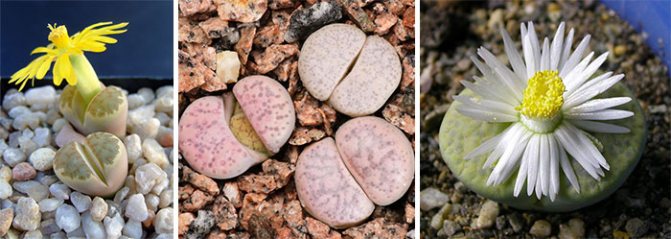

L. Dorothea, L. Franza, L. redhead
Lithops karassky (lat.Lithops karasmontana) is a living stone of the Karass mountains of Namibia with a pair of juicy gray leaves, the upper part of which is decorated with a pattern of dark brown veins. The structure and color of the succulent perfectly imitate the quartzite rock, so the plant is very difficult to find. In autumn, white flowers with narrow petals appear. A common species that has received an award from the Royal Horticultural Society of England.
Lithops Leslie (lat.Lithops lesliei) is a species that is practically exterminated in the natural environment due to its medicinal properties. It is a miniature indoor succulent with two brownish, flat at the top, leaves. The surface of the leaf has a relief of small tubercles. The bright yellow flower is located on a short, thickened peduncle. The most famous varieties:
- "Albinica" (Albinica) - green leaves, snow-white flowers.
- "Fred's Redhead" - red-pink leaves.
Lithops earthy or local (lat.Lithops localis, Lithops terricolor) differs, as the name implies, with brownish-brown leaves. The species is found only in a small area, in the Karoo region - a semi-desert in southern Africa. The appearance of the plant is characteristic of lithops - a pair of dense fleshy leaves separated by a gap, from which a bright flower appears.


L. karassky, L. Leslie, L. earthy
Lithops eye-like (lat.Lithops optica) is an unusual species native to Namibia, the appearance of which resembles an eyeball. The plant has rounded leaves with a translucent light window, between which a flower grows. In nature, the leaves are usually painted in a light green-green tone, but in room culture the most widespread variety is "Rubra" with very spectacular crimson-red or purple leaves. Unfortunately, in the wild, the plant is almost destroyed. This succulent, like the lithops of Compton, vegetates in the summer and rests in the winter.
Salt-growing lithops (Latin Lithops salicola) is a compact species with cylindrical or conical leaves with a flat surface, painted gray-green. The white flowers that emerge from the crevice between the leaves are also very miniature. The plant is often found in indoor culture, because differs in unpretentiousness.
Lithops warty (lat.Lithops verruculosa) stands out for a very unusual appearance: dense fleshy red-pink leaves have a relief surface consisting of burgundy dots resembling moles or warts. The native land of the species is the Republic of South Africa. The most effective variety is "Rose of Texas" with gorgeous pink flowers.


L. eye-like, L. saline, L. verrucous
Popular varieties
Breeders have bred many interesting varieties of lithops with different characteristics. In indoor floriculture, the most common:
- Lithops is beautiful. Grows in small groups. Diameter - up to 3 cm. Color - brown-yellow. Flowers - white, exude a pleasant light aroma.
- Lithops divided. The succulent group includes plants of various sizes (from 1 to 3 cm). The leaves are green, grow together only at the base. Above there are grayish spots. The flowers are yellow.
- Lithops Salleros. Paired leaves are gray. Grows in large groups. The width and height are the same - up to 2.5 cm. The slit is superficial. Color - olive green. Decorated with spots of a darker shade. Flowers are white.
- Lithops false truncated. Plants of different sizes from 1 to 3 cm grow in small groups. The leaves grow together only from below, the gap extends almost to the base. Color - grayish, brown, pinkish. On the surface there is a dark pattern - dots, strokes, lines. During flowering, bright yellow flowers bloom.
Important! All types of lithops contain poisonous, toxic substances. It is not recommended to grow a succulent plant in an apartment with small children and pets.
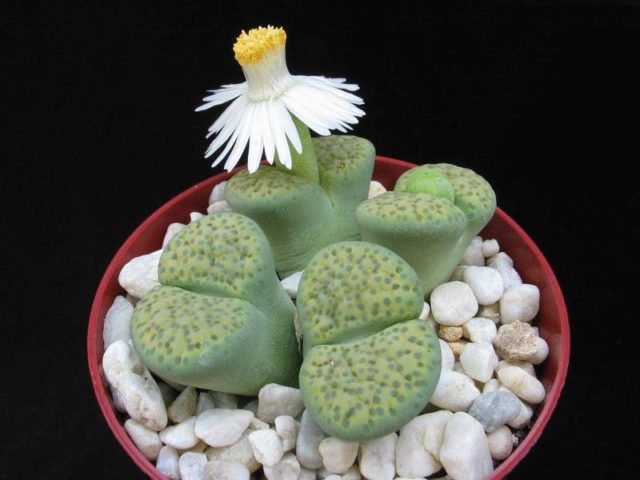

Lithops care at home
Growing these unusual succulents indoors is not difficult at all, but remember that caring for them depends entirely on the annual cycles of the plant. And the first thing a florist should pay attention to is the correct watering of lithops.
Watering, air humidity
At first glance, it may seem that the mode of watering desert exotic plants is a little confusing, however, knowing the annual cycle of the plant, you can easily understand the algorithm.
As mentioned above, at the beginning and in the middle of summer, the plants rest, stopping the growing season. This applies to both wild and domestic succulents. At this time, they need to be watered very moderately or not watered at all. In late summer or early autumn in Africa, the rainy season, lithops store moisture before flowering, so in August we restore watering, gradually reducing it until the end of September. When a flower appears, watering should be stopped completely and not resumed throughout the winter. Do not be afraid that the lithops will dry out - the plant has perfectly adapted to the lack of water.
In the spring, when a new pair of leaves is growing, watering should be started again, bringing it to a maximum by mid-April, and then reducing it by the end of May.
[!] Please note that some species of Lithops bloom in July, others in November, depending on the time of flowering, the watering time may vary slightly.
In addition to the above, there are several more important rules for watering lithops:
- Succulents react very badly to overflow: from an excess of moisture, their roots and leaves quickly rot. Therefore, watering should be very gentle and moderate.
- These plants store water with a long root, therefore it is important that moisture gets deep into the bowl. It is best to water live rocks by immersion or from a sump.
- The soil must dry out between waterings.
- Make sure that moisture does not get into the gap between the leaves, this can provoke the appearance of rotting spots.
- Water for irrigation should be filtered and warm.
As for the humidity of the air, it should be low. These representatives of the desert flora feel great in the dry air of apartments, so there is no need to spray them.
Temperature, lighting
In their homeland, Africa, lithops grow in extremely hot climates, so indoors they are able to withstand fairly high temperatures. A comfortable summer temperature for succulents is about 25 ° C. In winter, it can be slightly colder: from 15 ° C to 17 ° C, and the lower temperature limit is at least 10 ° C. In winter, many living stones suffer from the cold window panes. In order for the lithops not to freeze, you should move it to the edge of the window sill.
[!] Remember that low temperature combined with high humidity is especially destructive for live stones.
Lighting is another important factor in keeping lithops correct. The fact is that in nature this culture grows in open, well-lit areas, where there are no tall trees and shrubs giving shade. That is why, when growing at home, it is very important to provide the succulents with a sufficient amount of light: 4-5 hours of direct sun in the first half of the day and light partial shade in the second.
For lithops, southern, southeastern or eastern windows are perfect, a little worse - southwestern and western. It is strongly discouraged to place live stones on northern windowsills or in the back of the room.
[!] Succulents, deprived of sunlight, stretch ugly and lose their brightness, becoming pale green.
However, despite the obvious photophilousness, the plant can get sunburn. This usually happens in the spring, when cloudy weather suddenly gives way to bright sun. Lithops, having lost their resistance to light, does not have time to adapt and burns. In this case, it is recommended to gradually accustom the succulent to the bright sun.
Soil, top dressing
The composition of the substrate for lithops is as important as watering and good lighting. The soil should be rocky, poor, loose and have neutral acidity (pH up to 7.2). It is not recommended to use ready-made soil for cacti, because they contain too much peat. It is better to make up the soil mixture yourself according to the recipes below:
- 1 part of sheet earth, clay and brick chips, 1.5 parts of sand;
- 1 part of sand and pumice, 2 parts of clay soil;
- 1 part of leafy earth and river sand, 2 parts of quartz sand, brick chips and turf clay.
For better drainage, it is necessary to pour a high layer of drainage from below, and after planting a living stone, sprinkle the surface of the earth with small pebbles.
It is not necessary to feed desert plants, they are able to obtain all the necessary substances from soil and water.
Transplant, reproduction
Lithops can be transplanted no more than once every 3-4 years. They grow very slowly, so they do not need to constantly change dishes and soil. It is important to choose the right pot, which should be small but deep enough to accommodate the drainage and long roots of the plant.
According to experienced flower growers, lithops grow much better surrounded by neighbors than alone. Several species can be planted in one container at once or combined with other representatives of the Aiz family, for example, conophytum and lapidaria. Such a mini-garden imitating a desert landscape will look very impressive in the interior.


In nature, lithops reproduce vegetatively, growing several pairs of leaves, or with the help of seeds. Seed reproduction is widespread in culture, because grafting or dividing this plant is very difficult.
The seeds are carefully harvested from the fruit that appears after flowering, and are laid until the beginning of spring, when they begin to germinate according to the following scheme:
- Prepare the substrate: 1 part of peat and brick chips, 2 parts and turf clay.
- They fill containers with them, not forgetting about drainage.
- The earth is slightly moistened with a finely dispersed spray bottle.
- The seeds are soaked for several hours and, without drying, are sown into the prepared soil with a minimum (no more than 1 mm) deepening.
- The container is covered with transparent film or glass and transferred to a bright, warm room.
Seedlings should appear in a week, further care for them consists in daily airing (no more than 30 minutes per day) and watering. When the seedlings grow a little, you can cover the soil surface with small pebbles, which will prevent mold and serve as a kind of support for young plants. After a year, the grown seedlings can be carefully planted.


Remember that Lithops obtained from seeds grow very slowly and bloom only in the third year after planting.
Breeding features
Often, flower growers at home practice growing lithops from seeds. To do this, at the beginning of March, the seeds are soaked in a manganese solution for 6 hours, after which, without drying, they are distributed on the surface of the soil. To grow seedlings, sand, crushed red brick, clay soil and peat are mixed.
It is convenient to use a flat and wide box where the calcined and moistened soil mixture is placed. The dish is covered with glass and kept at a temperature of + 10 ... + 20 ° C. To accelerate seed germination, it is necessary to create a fluctuation between night and day temperatures. The difference between them should be 10-15 ° C. For several minutes every day, you need to ventilate the greenhouse, remove condensation and spray the soil with a spray bottle.
Seedlings become visible after 6-8 days. The land is stopped sprinkling and is watered with great care. Airing is now done more often, but the cover is not removed completely. After 1-1.5 months, the seedlings are cut to a permanent place, it is recommended to plant several tiny plants in one container at once.
Diseases and pests, methods of control
Important nuances:
- Most fans of exotic plants note that with proper care, problems with "living stones" rarely occur.
- Rotting of the roots is most often associated with violation of the rules of watering, incorrect alternation of the regime of dryness and moisture of the substrate.
- It is important that the humidity in the room where lithops grow is not too high, otherwise the fleshy base begins to rot.
- With the development of rot, the plant is treated with fungicides. Sometimes shriveled fleshy leaves cannot be brought back to life, the exotic species dies.
Pest Information:
- Parasites rarely settle on lithops; mealybugs may appear.
- To combat insects, effective insecticides are used: Aktara, Regent, Mospilan.
- If a pest is identified, the problem specimen must be quarantined.
It is more difficult if "living stones" grow next to other types of succulents, and it is problematic to extract the overgrown roots from the substrate. In this case, pests are collected, all species on which insects have settled are carefully processed. If the mealybug appears in the container, then other species with fleshy greens are probably affected.

